Justice Project Questions Murder Conviction
DNA tests and evidence tampering allegations raise questions about 2000 conviction of Ken Hudson.

Convicted murderer Ken Hudson addresses the court at his sentencing on April 3, 2001. Outagamie County Circuit Judge Harold Froehlich sentenced him to life in prison plus 73 years for the June 25, 2000, murder of Shanna Van Dyn Hoven in Kaukauna, Wis. Hudson, who has maintained his innocence, has been granted a new round of DNA testing. (Dan Powers/USA TODAY NETWORK-Wisconsin)
In his opening statement, prosecutor Vince Biskupic said blood found on Ken Hudson’s body came from Shanna Van Dyn Hoven, an athletic student at the University of Wisconsin-Madison home for summer break who was stabbed to death while jogging near her home in Kaukauna.
Police photos show Hudson’s left leg shining red, streaked with a red substance, as he lay handcuffed to a hospital bed. The substance ran from the middle of his shin down to his sandal, a little trickling between his toes. It was hours after police arrested Hudson following a 16-mile car chase through Wisconsin’s Fox Valley in June 2000.
Hudson’s arrest came after Dave Carnot, a welder, said in an interview for this story that he had heard his neighbor, Van Dyn Hoven, 19, scream about three times. Carnot, the son of a retired Kaukauna police officer, said he raced to Plank Road where he found Hudson standing by her body. A moment later, Carnot said, Hudson hopped in his pickup truck and tried to run him over before fleeing.
Biskupic alleged Hudson attacked Van Dyn Hoven in a misplaced fit of rage after Hudson, his mother and his girlfriend quarreled during a weekend camping trip.
But for 17 years, Hudson has stood by his claim of innocence — that he never touched Van Dyn Hoven, whom he said he found already grievously injured. A roofer with a criminal record, Hudson alleged that as he lay in the back of two squad cars, police officers poured and smeared a red substance on him.

Ken Hudson is seen in the back of a police squad car after he was arrested in a June 25, 2000, murder in Kaukauna, Wis. Hudson claims the red liquid on his body was poured and smeared on him by police. Post-conviction testing of samples from his body has found either no DNA or just a sequence matching Hudson and people related to him through his mother going back many generations. (Outagamie County Sheriff’s Department)
The results of several rounds of DNA testing have yielded puzzling results that raise questions about whether the provocative allegation by Hudson, now 48, could be true. Another round of testing financed by Hudson’s former long-time girlfriend, Danita Metko, and her husband, Gene, is underway.
Half a dozen DNA experts consulted by The Medill Justice Project and by Hudson’s attorney say the results are hard to explain.

Shanna Van Dyn Hoven, 19, was stabbed to death on June 25, 2000, in Kaukauna, Wis. Ken Hudson is serving a life term for the murder. (Outagamie County Circuit Court file)
The allegations of evidence planting are among numerous charges of police and prosecutorial misconduct outlined in a series of appeals filed by Hudson. They include gaps in the police dispatch tape of the chase in which references to a stabbing are not there; a possible second vial of the victim’s blood taken during her autopsy that is unaccounted for; and the mysterious erasing of what police said was Hudson’s videotaped confession, which a forensic tape analyst said could not have been accidental. Hudson said he did not confess.
Police also testified they found a Remington hunting knife in Hudson’s truck — although their written reports conflict about whether it was on the passenger or driver’s side floor. Hudson’s DNA was not found on the knife and, his attorneys have charged, neither were his fingerprints. Hudson has alleged that police removed the knife still in its packaging from behind his seat and planted it on the floor, at some point smearing it with Van Dyn Hoven’s blood.
Former Outagamie County District Attorney Carrie Schneider, who handled the case on appeal, is now an Outagamie County Circuit Court judge. She declined to comment. Biskupic, who also now sits on the Outagamie County bench, declined comment, citing a Supreme Court rule that generally prohibits judges from commenting on pending cases.
Prosecutors have labeled the allegations of widespread misconduct “ludicrous.”
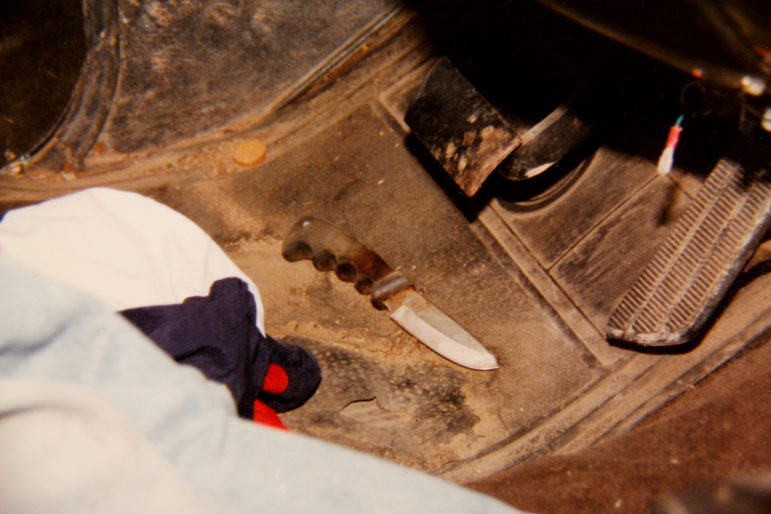
In Ken Hudson’s latest appeal, his attorney argues that officers gave conflicting testimony about where the knife was in his truck when he was arrested after a police chase on June 25, 2000, for a murder in Kaukauna, Wis. Hudson, who is serving a life term, claims police planted the alleged murder weapon on the floor of his truck. (Outagamie County Sheriff’s Department)
In interviews for this story, two witnesses who saw Hudson before he was arrested and after Van Dyn Hoven was stabbed — Carnot and Kaukauna resident Matthew Brittnacher — said they do not remember seeing blood on Hudson. Both emphasized, however, they were not looking for blood. And Brittnacher said his view of Hudson was from “too far away.” Carnot and Brittnacher said they are certain Hudson is guilty.
“There’s a lot of innocent people in prison,” Brittnacher told The Medill Justice Project, “but he’s not one of them.”
Blood evidence contradictory
Questions about the blood evidence have long swirled around the case.
Hudson and his attorneys have discovered that analysts found no blood on the steering wheel, gear shift or driver’s side floor in Hudson’s truck, although his right hand and left leg were streaked with red and a knife was found on the floor. And although Hudson stopped during the chase to unhook a boat from his truck — an episode witnessed by Brittnacher — analysts found no blood on the trailer or boat.
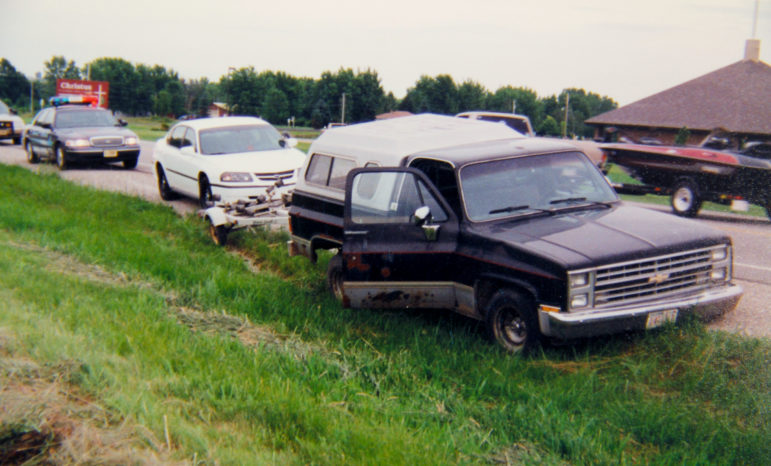
Ken Hudson’s truck is parked after he led police on a 16-mile chase. He has alleged on appeal that police and prosecutors framed him. (Outagamie County Sheriff’s Department)
In a post-conviction hearing, Hudson testified he opened his truck door to Van Dyn Hoven, who then sat bleeding on the passenger side only to quickly flee when she saw Carnot coming out of the woods. Thinking Carnot was coming to attack him, Hudson testified that he sped off, striking him with his truck.
In 2000, a Wisconsin State Crime Laboratory analyst found the red substance on Hudson’s left foot was not human blood. He found DNA from Hudson and Van Dyn Hoven on his right hand.
The analyst, John Ertl, testified at Hudson’s 2001 murder trial that he chose to test the sample from Hudson’s left foot because “it looked very bright, and it looked like there was a lot of blood there.”
Ertl found no human DNA.
“That turned out to not be human blood,” Ertl testified.
In fact, he said, there was no human DNA detected in two tests of blood samples from Hudson’s left foot.

Ken Hudson is seen at St. Elizabeth Hospital in Appleton, Wis., after his arrest for the June 25, 2000, murder of Shanna Van Dyn Hoven. DNA testing has found the victim’s DNA on Hudson’s sandals but not on his feet. Initial testing also found a combination of Hudson’s and the victim’s DNA on his right hand, but later testing found no DNA. (Outagamie County Sheriff’s Department)
In 2003, Ertl changed his testimony, saying in response to Hudson’s request for DNA testing that the blood found on Hudson’s left foot was human but that he could not detect any DNA in it. The state later reversed itself, saying in 2004 that there was animal blood found on Hudson and it could have come from fish he caught during his camping trip.
And although evidence photos show Hudson streaked by what appeared to be blood, the follow-up testing in 2005 found no DNA in the samples from Hudson’s right hand — where Ertl had earlier detected Hudson’s and Van Dyn Hoven’s DNA.
Ertl did not respond to multiple requests seeking comment about the conflicting results, which he himself has described in court as “weird.”

An aeriel view of Plank Rd., where Shanna Van Dyn Hoven was murdered near a gravel quarry. Two men, Ken Hudson and David Carnot, say they came across Van Dyn Hoven after she was stabbed. Hudson was convicted in the murder. (Exhibit from Ken Hudson trial)
In January, Outagamie County Circuit Judge Gregory Gill granted another round of testing after defense attorney Steve Miller argued that the substance found on Hudson was tampered with — or was not even blood at all.
Hudson’s post-conviction motion for DNA testing seeks to discover if samples from his left foot and right hand contain human or animal blood, and whether there was any substance added to the samples that could have degraded the DNA.
If not human blood, what is it?
In the motion for new testing, Miller wrote that he had consulted with Joan Gulliksen of Cellmark Laboratories and Stephen Erickson of LabCorp., who in turn consulted with others in the field.
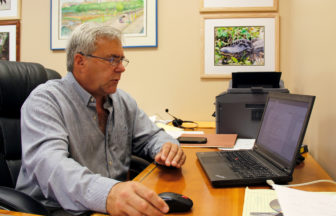
Ken Hudson is represented by attorney Steve Miller, who filed the motion for DNA testing that was granted in early 2017. Results of that testing could reveal what the red substance found on Hudson’s left foot and right hand was and, if it was blood, why some testing has found either no DNA or just a sequence matching Hudson and certain relatives. (Dee J. Hall / Wisconsin Center for Investigative Journalism)
“They and their colleagues found the lack of DNA extraction inexplicable under these circumstances as blood this fresh typically has a generous amount of DNA material,” he wrote.
In an interview, Miller said despite several rounds of testing, the source of the red substance found on Hudson remains a mystery.
“Is it human blood?” Miller asked. “If it is human blood, has it been contaminated? If it’s not even blood, what is it?
“I think either way, if we get a result showing either it’s human blood and it’s been, you know, contaminated to the point where there’s no DNA in it, or it’s not blood at all, that would significantly taint the evidence against Ken and it would also corroborate his account that the blood was in fact poured on him — which is what he’s alleged from the beginning. Because there would be no other explanation.”
Confusing results prompt questions
Experts consulted by The Medill Justice Project at Northwestern University were similarly confounded by the inconsistent test results.
In an interview for this story, David Foran, director of the Forensic Science Graduate Program at Michigan State University and the university’s Forensic Biology Laboratory, said one theory is the DNA tested by the state crime lab degraded over time.
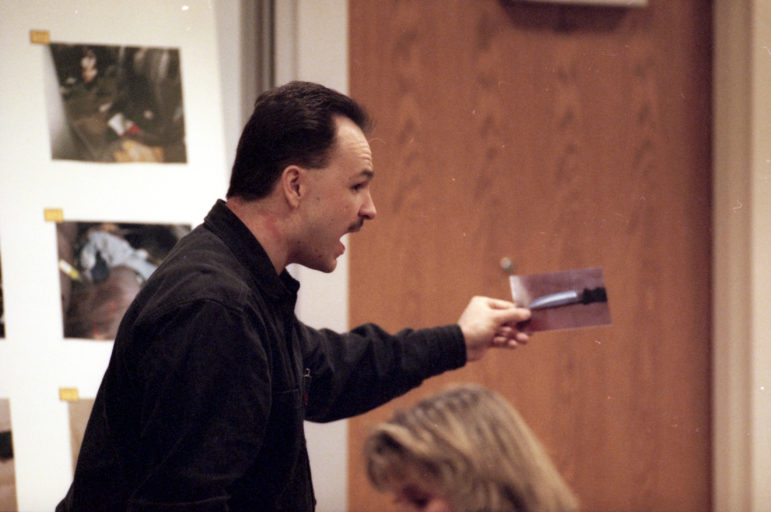
Ken Hudson, serving as his own attorney, shows a photo of the alleged murder weapon during his March 2001 trial at the Outagamie County Justice Center in Appleton, Wis. Hudson was found guilty of first-degree intentional homicide. He has appealed his conviction, alleging that he was framed. (Dan Powers / USA TODAY NETWORK-Wisconsin)
But given the brief time between Hudson’s arrest and when the samples were taken — about two and a half hours — it is unlikely the DNA would have degraded before the first set of tests. “It’d be hard to do anything to blood, human blood, in two hours to kill off all the DNA like that,” Foran said.
If someone had added a contaminating substance like bleach, Ertl would have been able to detect it from the change in the blood’s appearance, Foran said.
“As he did say in his testimony, that would most likely change the appearance of the blood too,” Foran said. “… I’m guessing it’s going to screw it up. A lot.”
Covered in blood?
Outagamie County Sheriff’s Department Sgt. Daniel Pamenter was dispatched to photograph the scene of Hudson’s arrest about 15 minutes after the chase had crossed through Appleton, according to his police report. Pamenter took pictures of Hudson lying down in the police squad car, noting the copious amounts of dried blood on his body.
“Hudson was photographed while laying down on the seat and his feet were photographed because of what appeared to be dried blood … on his legs and feet, as well as some on his arms, stomach and chest areas,” Pamenter wrote in his police report.

Ken Hudson is seen in the back of a police squad car after he was arrested in a June 25, 2000, murder in Kaukauna, Wis. Hudson claims the red liquid on his body was poured and smeared on him by police. Several rounds of DNA testing have raised questions about whether the substance is human blood. (Outagamie County Sheriff’s Department)
After Hudson was taken to St. Elizabeth Hospital in Appleton, Pamenter and Kaukauna police officer Don Krueger collected DNA samples in what is considered a typical process, using cotton swabs and four-inch gauze pads.
In addition to Hudson’s left foot, Ertl tested samples from the accused’s left arm, right foot and left chest — and all three showed the presence of blood. Those samples, however, were not tested for DNA.
Ertl was unable to extract human DNA from samples taken from Hudson’s left foot, records show. Given the significant amount of what appeared to be blood, Foran said, it was unusual to find no human DNA.

The knife that prosecutors say Hudson used in the murder of Shanna Van Dyn Hoven. Hudson claims that the knife, which was in his truck, was removed from its packaging, smeared with her blood and planted on the floor. (Outagamie County Sheriff’s Department)
“That makes little or no sense,” Foran said.
Ashley Hall, an assistant professor of biopharmaceutical sciences at the University of Illinois at Chicago, said the DNA could have been degraded or contaminated before the samples were taken, despite the significant amount of blood involved.
“There are a lot of different things that can go wrong,” Hall said. Any activity Hudson participated in could have interfered with the DNA tested, she said.
“In practice, (DNA testing) doesn’t always work like we want it to,” Hall said.
According to Hudson, he spent nearly two hours handcuffed in the back of squad cars after being chased down by police. He said he fled the murder scene because he had a suspended driver’s license and marijuana in his possession.
After he was arrested, Hudson — who had consumed Valium and alcohol and smoked pot — said he fell asleep and awoke to a strange sensation.
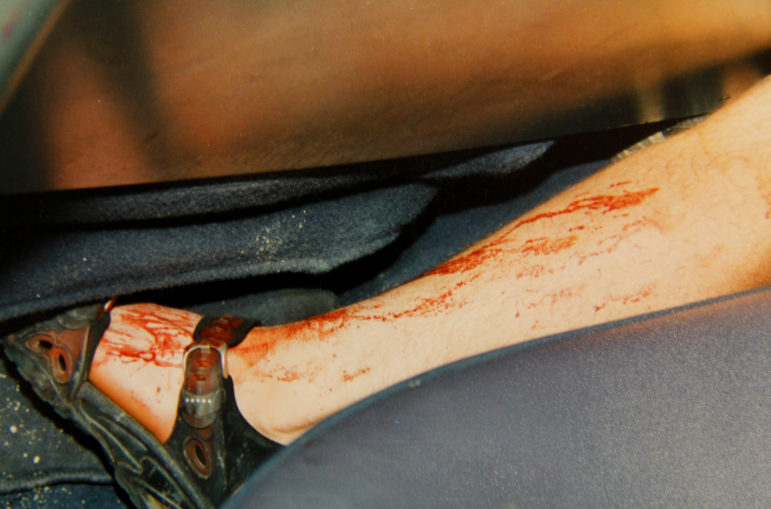
Ken Hudson’s left leg appears covered in blood in the back of a squad car after his June 25, 2000, arrest. Although the victim’s DNA was found on Hudson’s sandal, the State Crime Lab and private labs hired by the defense have found either no DNA or just a sequence matching Hudson and certain relatives on his left foot. (Outagamie County Sheriff’s Department)
“I had fell asleep in the back of the squad car. I awoke to a warm feeling running down my leg,” Hudson testified during a 2003 post-conviction hearing. “And when I awoke, it was a police officer that had a cup. And he was pouring blood on my leg, and I said, ‘Stop this. What are you doing?’”
Hudson said he kicked the cup out of the officer’s hand. He testified officers then moved him to another squad car, and this time two officers opened the doors. He testified that one officer told him, “ ‘I’m going to loosen your cuff up a little’ and they were messing with my hands back there. And then he took a paper towel and wiped my face … Then he had wiped my chest a couple of times. Then I started to fight.”

Acting as his own attorney, Ken Hudson questions a police officer during his murder trial in March 2001 in Outagamie County Circuit Court in Appleton, Wis.
In a post-conviction motion, Hudson alleged it was Kaukauna Police Sgt. Robert Patschke, the officer who had initially led the car chase, who poured blood on him. He could not identify the other two officers.
Patschke declined to comment, saying this 17-year-old case was “personal” as he knew the victim’s family.
Results on right hand confounding
After Hudson’s arrest, the State Crime Laboratory also tested a sample from what appeared to be dried blood on Hudson’s right hand.
In 2001 testimony, Ertl, the DNA analyst, said he first performed a chemical test to determine whether the sample was indeed blood and then analyzed the samples with what is known as the polymerase chain reaction and a short tandem repeat test.
The short tandem repeat helps to distinguish one individual’s DNA from another’s and the polymerase chain reaction creates copies of the DNA to create more material to test. Copies are needed because sample sizes are so small. The result: Ertl found Van Dyn Hoven’s and Hudson’s DNA on his right hand.
In 2005, Ertl testified that he had also run a more specific test known as an ABAcard HemaTrace test used to detect if the samples from the right hand, the left foot and right foot were human blood by identifying the presence of proteins within it. All three tested positive for human blood, he said.
But in 2001, Ertl had testified the sample from the left foot was not human blood. Hudson said in a prison interview that his attorney plans to raise this discrepancy in court.
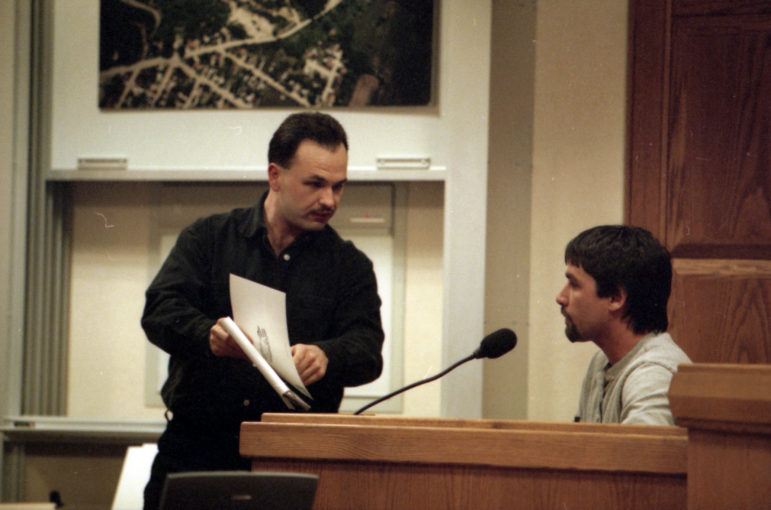
Acting as his own attorney, Ken Hudson questions David Carnot during his murder trial in March 2001 in Outagamie County Circuit Court in Appleton, Wis. Carnot and Hudson both say they came upon victim Shanna Van Dyn Hoven after she was wounded. Carnot, whose father had retired after a long career with the Kaukauna Police Department, was cleared early in the investigation. (Dan Powers / USA TODAY NETWORK-Wisconsin)
In 2005, in subsequent testing by the defense to determine the animal species, Irving Kornfield, a University of Maine professor and forensics expert, found no animal or human DNA from a sample obtained from Hudson’s right hand. Kornfield died in April. In other samples, Kornfield did find human DNA — a single DNA sequence that matches Hudson and others related to him through his mother going back many generations.
Ertl testified that one possible reason the Maine lab found no DNA in some of the samples was that someone added an inhibitory substance to the sample or there was some biological contamination, like the presence of battery acid, caustic chemicals or salt concentrations, such as mineral deposits.
“I don’t know whether or not there’s inhibitory substances there — but that would be my best guess as to why I could detect it using a non-amplified process where they couldn’t detect it using an amplified process,” Ertl said. “Another explanation may be I took a cutting from a swab. They took a different cutting from that swab. The amount of DNA on those two cuttings could very well be different.”
Ertl did note, however, that Kornfield had used a more sensitive testing method involving what is known as mitochondrial DNA and so the DNA should have been detected in the sample.
Theodore Kessis, the founder of Applied DNA Resources, a Columbus, Ohio firm specializing in the review of forensic DNA testing, said in an email, “Dr. Kornfield’s test for (mitochondrial) DNA was much more sensitive than the nuclear DNA … test the Wisconsin State Crime Lab was using. While a typical human cell contains only two copies of nuclear or chromosomal DNA, that same cell contains 1000’s (sic) of (mitochondrial) DNA which are much easier to detect.”
In his 2005 testimony, Ertl said it is possible an inhibitory substance was added to the sample. He said any substance that would affect the DNA would also affect the proteins in the blood, possibly changing its appearance.
“(I)f that DNA is in a bright red stain on the swab, I would think that would be a good candidate to get DNA from,” he testified. “I’ve taken blood stains that looked black or green or had mold growing on them and I can still get DNA from them. But those are more effects of time and biological degradation. Whereas I’m not so sure what the effects of a chemical attack on the DNA would have on the appearance of the blood.”
Kessis said the most likely explanation was that the sample had degraded while in storage. “I have seen several cases in which the DNA molecules have degraded in much (less) time.” He added that the degradation may have been due to the humidity or temperature in the storage facility.
Testing, analysis can be fallible
The Innocence Project in New York has documented several cases where an innocent person was convicted on the basis of mismanaged DNA testing. Post-conviction DNA testing also has produced exculpatory evidence.
In 1996, for example, Marlon Pendleton was convicted of sexual assault and robbery in Chicago. A Chicago police crime lab analyst said at the time that there was not enough evidence available for conclusive DNA testing.
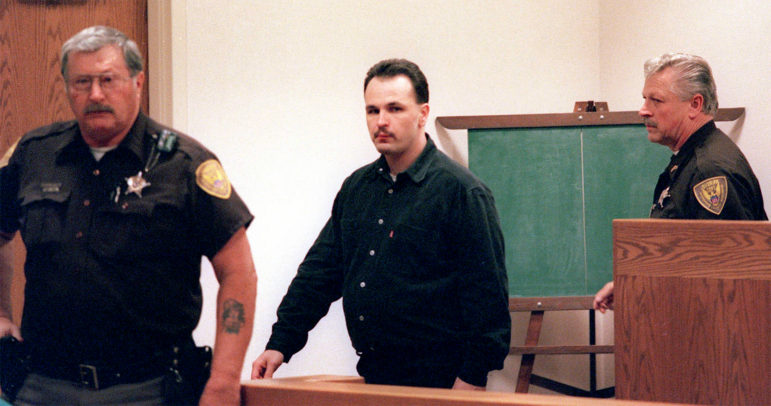
Ken Hudson, center, enters an Outagamie County courtroom in Appleton, Wis., on March 9, 2001, to hear the jury’s verdict following his murder trial. Hudson was found guilty of first-degree intentional homicide in the murder of Shanna Van Dyn Hoven. (Dan Powers / USA TODAY NETWORK-Wisconsin)
But nearly a decade later, the Center on Wrongful Convictions at Northwestern University’s School of Law arranged for a second round of DNA testing on the same evidence. The testing, which was completed on a vaginal swab taken from the victim, excluded Pendleton as the perpetrator.
In 1999, Josiah Sutton was convicted of rape, and the Houston Police Department Crime Laboratory said a semen sample from the victim contained Sutton’s DNA. Two local reporters, who wrote articles critical of the police crime lab’s forensic analysis, sent Sutton’s reports to William Thompson, a criminology professor at the University of California-Irvine, who concluded the lab was wrong. The semen had not come from Sutton.
“Based on the laboratory notes, it appears that the procedures employed by the HPD Serology/DNA Unit in this case fell well below accepted professional standards for quality scientific work,” Thompson wrote in his review.
An audit uncovered widespread problems at the lab ranging from incorrect interpretation of data to a lack of paperwork, and the police department suspended DNA testing, according to the final report by an independent investigation. Sutton was exonerated in 2004.
In an interview for this story, Rena Xian, an assistant professor of molecular pathology and hematopathology at the University of California-Los Angeles, said several things can go wrong in DNA testing.
“DNA testing is not an infallible process; nothing is,” Xian said. “Many things can go wrong depending on the method or the amount of DNA collected. If there is too little, it may not be enough and the amount might be below the level of sensitivity required for the test, if the test is reliant on it.”
She added in an email, “Contamination, if present, usually happens prior to the sample arriving in the lab.”

Danita (Scharenbroch) Metko and her husband, Gene, are financing the latest DNA testing and appeal for Ken Hudson, her former boyfriend. “I don’t believe Ken did it,” Gene Metko said. “It’s a horrible tragedy to see him in there, and I’d like to see him out.” (Dee J. Hall / Wisconsin Center for Investigative Journalism)
Gene Metko, Hudson’s friend, hopes the latest round of testing will finally answer some of those questions.
“I don’t think Kenny’s guilty,” he said. “I really don’t.”
His wife, Danita, Hudson’s former girlfriend, said, “I totally 100 percent believe he’s innocent … the Lord’s on his side. And I just pray for the truth to come out.”
This investigation was conducted by seven graduate students at Northwestern University as part of an investigative journalism course taught by Professor Alec Klein, director of The Medill Justice Project, which supported the class work. Amanda Westrich, director of operations at MJP; Allisha Azlan and Rachel Fobar, MJP associates; Dee J. Hall, co-founder and managing editor of the Wisconsin Center for Investigative Journalism; and Alexandra Hall, a Wisconsin Public Radio Mike Simonson Memorial Investigative Reporting Fellow, also contributed to this report. The Wisconsin Center for Investigative Journalism’s reporting on criminal justice issues is supported by a grant from Vital Projects at Proteus. The nonprofit Center (www.WisconsinWatch.org) collaborates with Wisconsin Public Radio, Wisconsin Public Television, other news media and the UW-Madison School of Journalism and Mass Communication. All works created, published, posted or disseminated by the Center do not necessarily reflect the views or opinions of UW-Madison or any of its affiliates.
If you think stories like this are important, become a member of Urban Milwaukee and help support real, independent journalism. Plus you get some cool added benefits.
Flawed Forensics
-
Conviction Overturned After Flawed Hair Analysis
 May 22nd, 2018 by Dee J. Hall
May 22nd, 2018 by Dee J. Hall
-
State Won’t Review Flawed FBI Hair, Fiber Cases
 Nov 3rd, 2017 by Katherine Proctor
Nov 3rd, 2017 by Katherine Proctor
-
Flawed Hair Analysis Wrongly Imprisons Many
 Oct 25th, 2017 by Katherine Proctor and Dee J. Hall
Oct 25th, 2017 by Katherine Proctor and Dee J. Hall


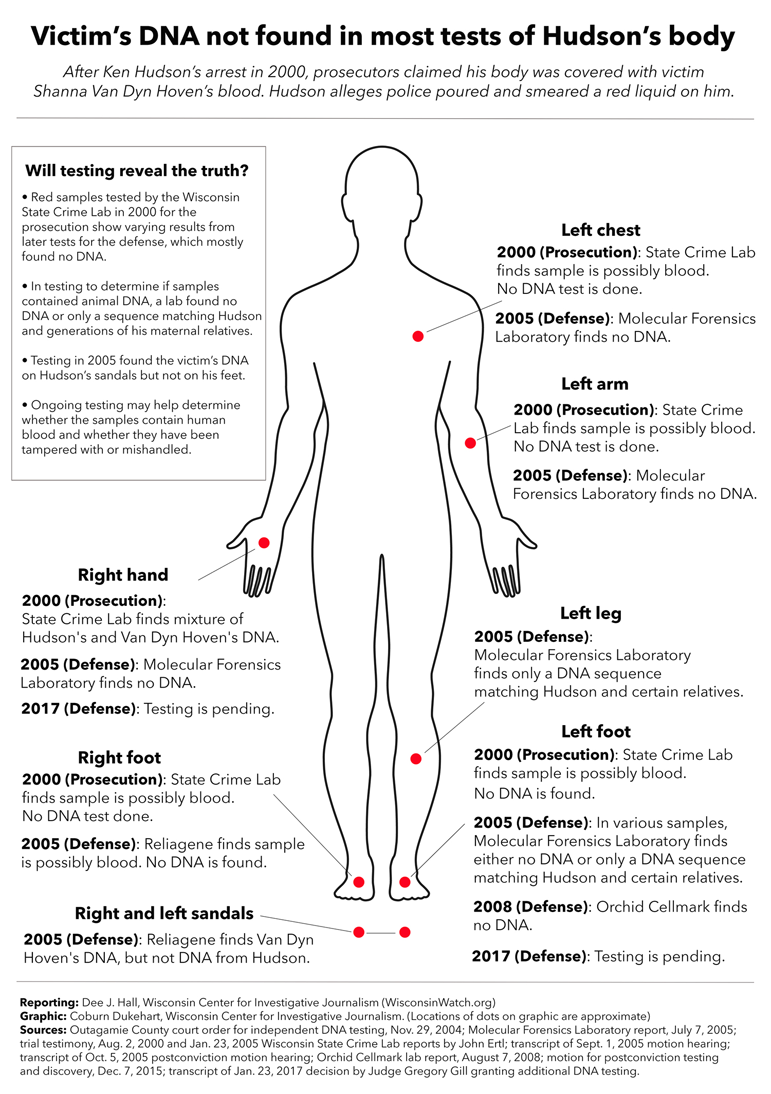



















Hudson did not stop to unhook a boat trailer. It is right there in the photo. He did lose the boat off of the trailer by his violent driving to escape the murder scene. Carnot responded to the woman’s screams and came upon the scene armed with a rake. He saw Hudson push Van Dyn Hoven out of his pickup and Hudson then tried to run down Carnot down with his pickup truck, striking a fence in the process and losing the boat off of the trailer which was later found in the roadway. I can’t explain the bungled testing on the blood but to even suggest Hudson is innocent with all of the other overwhelming evidence is ludicrous.
Correct spelling of my name is Wilson.